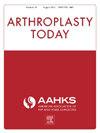Femoral Fixation for Primary Total Hip Arthroplasty—An International Registry Perspective
IF 2.1
Q3 ORTHOPEDICS
引用次数: 0
Abstract
Background
The preferred method for femoral fixation (FF) during total hip arthroplasty (THA) has varied internationally. While prior studies explored trends within single countries or small international cohorts, there’s a paucity of studies comparing international trends of FF for primary THA patients. This study analyzed global trends in FF methods, survival by fixation type, and periprosthetic fractures as a reason for revision.
Methods
Data were extracted from 2000 to the present from 16 national joint replacement registries. Data were collected on the number of cemented and uncemented primary THA cases each year. Revision and survival data were analyzed by fixation method. Aggregate data on periprosthetic fractures as a reason for revision and specific data on periprosthetic fractures by fixation method were included when available.
Results
A global shift from cemented to uncemented FF was observed over the past two decades, except in the Netherlands. Even in countries favoring cementation, such as Sweden, uncemented techniques are gaining popularity. Survival rates for cemented and uncemented methods were comparable, but periprosthetic fracture rates varied regionally. Preferences reflected both clinical practice differences and patient needs.
Conclusions
Most countries investigated show a preference for uncemented fixation. However, the popularity of cemented fixation in certain countries reflects its continued relevance, especially in populations with different clinical needs. Survival by fixation method was similar among countries, but periprosthetic fracture as reason for revision varied widely.
原发性全髋关节置换术的股骨固定-国际注册视角
背景:在全髋关节置换术(THA)中,股骨固定(FF)的首选方法在国际上有所不同。虽然先前的研究探讨了单个国家或小型国际队列的趋势,但比较原发性THA患者FF的国际趋势的研究很少。本研究分析了FF方法的全球趋势、固定类型的生存率以及假体周围骨折作为翻修的原因。方法从2000年至今的16个国家关节置换术登记处提取数据。每年收集骨水泥和非骨水泥原发性THA病例的数据。用固定法分析修复和生存资料。假体周围骨折作为翻修原因的汇总数据和固定方法引起的假体周围骨折的具体数据在可用时被纳入。结果在过去的二十年中,除荷兰外,全球范围内观察到从骨水泥到非骨水泥FF的转变。即使在瑞典等青睐固井技术的国家,非固井技术也越来越受欢迎。骨水泥和非骨水泥方法的存活率相当,但假体周围骨折的发生率因地区而异。偏好反映了临床实践差异和患者需求。结论大多数国家倾向于采用非骨水泥固定。然而,骨水泥固定在某些国家的流行反映了其持续的相关性,特别是在具有不同临床需求的人群中。各国采用固定方法的生存率相似,但假体周围骨折作为翻修原因的差异很大。
本文章由计算机程序翻译,如有差异,请以英文原文为准。
求助全文
约1分钟内获得全文
求助全文
来源期刊

Arthroplasty Today
Medicine-Surgery
CiteScore
2.90
自引率
0.00%
发文量
258
审稿时长
40 weeks
期刊介绍:
Arthroplasty Today is a companion journal to the Journal of Arthroplasty. The journal Arthroplasty Today brings together the clinical and scientific foundations for joint replacement of the hip and knee in an open-access, online format. Arthroplasty Today solicits manuscripts of the highest quality from all areas of scientific endeavor that relate to joint replacement or the treatment of its complications, including those dealing with patient outcomes, economic and policy issues, prosthetic design, biomechanics, biomaterials, and biologic response to arthroplasty. The journal focuses on case reports. It is the purpose of Arthroplasty Today to present material to practicing orthopaedic surgeons that will keep them abreast of developments in the field, prove useful in the care of patients, and aid in understanding the scientific foundation of this subspecialty area of joint replacement. The international members of the Editorial Board provide a worldwide perspective for the journal''s area of interest. Their participation ensures that each issue of Arthroplasty Today provides the reader with timely, peer-reviewed articles of the highest quality.
 求助内容:
求助内容: 应助结果提醒方式:
应助结果提醒方式:


